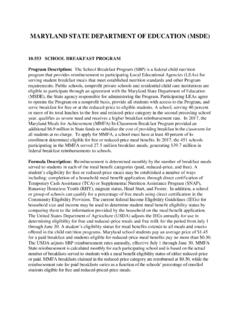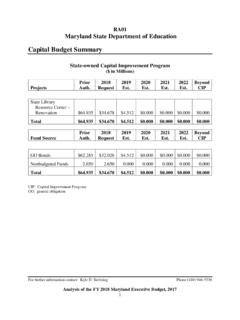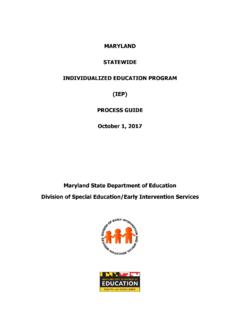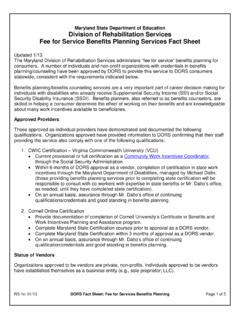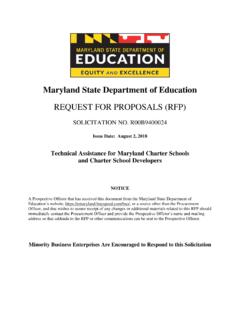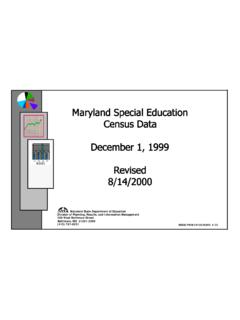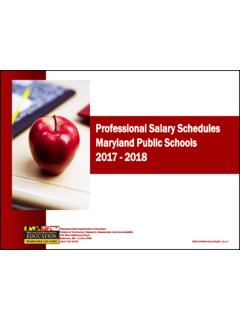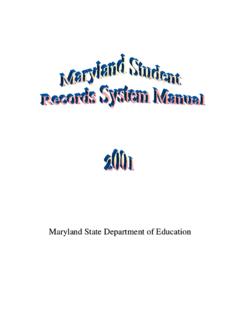Transcription of MARYLAND STATE DEPARTMENT OF EDUCATON (MSDE)
1 MARYLAND DEPARTMENT OF EDUCATION (MSDE) MARYLAND STATE DEPARTMENT OF EDUCATON (MSDE) SCHOOL BREAKFAST PROGRAM Program Description: The School Breakfast Program (SBP) is a federal child nutrition program that provides reimbursement to participating Local Educational Agencies (LEAs) for serving student breakfast meals that meet established nutrition standards and other Program requirements. Public schools, nonprofit private schools and residential child care institutions are eligible to participate through an agreement with the MARYLAND STATE DEPARTMENT of Education (MSDE), the STATE agency responsible for administering the Program. Participating LEAs agree to operate the Program on a nonprofit basis, provide all students with access to the Program, and serve breakfast for free or at the reduced-price to eligible students. A school, serving 40 percent or more of its total lunches in the free and reduced-price category in the second preceding school year, qualifies as severe need and receives a higher breakfast reimbursement rate.
2 In 2016, the MARYLAND Meals for Achievement (MMFA) In-Classroom Breakfast Program provided an additional $ million in STATE funds to subsidize the cost of providing breakfast in the classroom for all students at no charge. To apply for MMFA, a school must have at least 40 percent of its enrollment determined eligible for free or reduced-price meal benefits. In 2016, the 477 schools participating in the MMFA served million breakfast meals, generating $ million in federal breakfast reimbursements to schools. Formula Description: Reimbursement is determined monthly by the number of breakfast meals served to students in each of the meal benefit categories (paid, reduced-price, and free). A student s eligibility for free or reduced-price meals may be established a number of ways including: completion of a household meal benefit application, through direct certification of Temporary Cash Assistance (TCA) or Supplemental Nutrition Assistance Program (SNAP), Runaway Homeless Youth (RHY), migrant status, HeadStart, and Foster.
3 In addition, a school or group of schools can qualify for a percentage of free meals using direct certification in the Community Eligibility Provision. The current federal Income Eligibility Guidelines (IEGs) for household size and income may be used to determine student meal benefit eligibility status by comparing them to the information provided by the household on the meal benefit application. The United states DEPARTMENT of Agriculture (USDA) adjusts the IEGs annually for use in determining eligibility for free and reduced-price meals and free milk for the period from July 1 through June 30. A student s eligibility status for meal benefits extends to all meals and snacks offered in the child nutrition programs. MARYLAND school students pay an average price of $ for a paid breakfast and students eligible for reduced-price meal benefits pay no more than $ The USDA adjusts SBP reimbursement rates annually, effective July 1 through June 30.
4 MMFA STATE reimbursement is calculated monthly for each participating school and is based on the actual number of breakfasts served to students with a meal benefit eligibility status of either reduced-price or paid. MMFA breakfasts claimed in the reduced-price category are reimbursed at $ , while the reimbursement rate for paid breakfasts varies as a function of the schools percentage of enrolled students eligible for free and reduced-priced-price meals. MARYLAND DEPARTMENT OF EDUCATION (MSDE) Federal reimbursement rates for FY 2017: School Breakfast Program Free Reduced-Price Paid Non-Severe Need Rate $ $ $.29 Severe Need Rate $ $ $.29 Program Supported/Population Served: Statewide Program, school year 2015-2016 data: Supported 45,529,433 meals in all 25 LEAs including The Seed School and qualifying nonprofit private schools and residential childcare institutions also received assistance.
5 NATIONAL SCHOOL LUNCH PROGRAM Program Description: The National School Lunch Program (NSLP) is a federal child nutrition program that provides reimbursement to participating Local Educational Agencies (LEAs) for serving student lunch meals and snacks in after-school care programs that meet established nutrition standards and other Program requirements. Schools participating in the after-school care snack program are required to have an educational or enrichment component and, if the area eligible requirements are met, may claim all snacks served at the free rate of reimbursement. Schools not meeting the area eligibility requirement may claim after-school care snack reimbursement based upon the meal benefit eligibility status of the students served. Public schools, nonprofit private schools, and residential childcare institutions are eligible to participate through an agreement with MSDE, the STATE Agency responsible for administering the Program.
6 Participating LEAs agree to operate the Program on a nonprofit basis, provide all students with access to the Program, and serve lunch/snack at the free or reduced-priced-price to eligible students. Formula Description: Reimbursement is determined monthly by the number of lunch meals and after-school care snacks served to students in each of the meal benefit categories (paid, reduced-priced, and free). A student s eligibility for free or reduced-priced-price meals may be established a number of ways including: completion of a household meal benefit application, through direct certification of Temporary Cash Assistance (TCA) or Supplemental Nutrition Assistance Program (SNAP), Runaway Homeless Youth (RHY), migrant status, HeadStart, and Foster. In addition, a school or group of schools can qualify for a percentage of free meals using direct certification in the Community Eligibility Provision.
7 The current federal Income Eligibility Guidelines (IEGs) for household size and income may be used to determine student meal benefit eligibility status by comparing them to the information provided by the household on the meal benefit application. The United states DEPARTMENT of Agriculture (USDA) adjusts the IEGs annually for use in determining eligibility for free and reduced-price meals and free milk for the period from July 1 through June 30. A student s eligibility status for meal benefits extends to all meals and snacks offered in the child nutrition programs. MARYLAND school students pay an average price of $ for a paid lunch and students eligible for reduced-priced-price meal benefits pay no more than $ for lunch and $ for a snack. The USDA adjusts NSLP reimbursement rates annually, effective July 1 through June 30. Included in the reimbursement MARYLAND DEPARTMENT OF EDUCATION (MSDE) rate is an additional six cent performance based reimbursement paid to LEAs serving MSDE certified lunch menus that meet the increased nutritional standards of the Health Hunger Free Kids Act of 2010.
8 LEAs that served 60 percent or more of total lunches in the free and reduced-price category in the second preceding school year qualify for an additional $ for each lunch served. Additionally, LEAs are eligible to receive commodity foods, called entitlement foods; the level of funding is determined by the number of lunches served at a value of $ for each lunch meal. Federal reimbursement rates for FY 2017: Lunch Rates Free Reduced-Price Paid Reimbursement rate $ $ $ With extra $ $ $ $ Program Supported/Population Served: Statewide Program, school-year 2015-2016 data: Supported 73,324,118 lunch meals in all 25 LEAs including The Seed School and supported 900,594 in after-school snacks. Qualifying nonprofit private schools and residential child care institutions also received assistance. SPECIAL MILK PROGRAM FOR CHILDREN Program Description: The Special Milk Program (SMP) is a federal child nutrition program that provides reimbursement to participating agencies for half pints of milk served to children.
9 The Program provides milk to children in schools and child care institutions that are not participating in another federal meal program. Agencies are eligible to participate through an agreement with MSDE, the STATE agency responsible for administering the Program. Formula Description: Reimbursement is determined monthly by the number of half pints of milk served to eligible children multiplied by the reimbursement rate. The paid rate is used for After-School Snacks Served in After-School Care Programs Free Reduced-Price Paid $.86 $.43 $.07 Commodity Entitlement $.23 for lunches MARYLAND DEPARTMENT OF EDUCATION (MSDE) each half pint of milk served unless the agency has elected to operate a pricing program with free milk for eligible children. If this option is selected, the agency must determine children s eligibility status for free milk benefits. A student s eligibility for free milk may be established a number of ways, including the completion of a household meal benefit application by the student s parent or guardian.
10 The current federal Income Eligibility Guidelines (IEGs) for household size and income may be used to determine student meal/milk benefit eligibility status by comparing them to the information provided by the household on the meal benefit application. The United states DEPARTMENT of Agriculture (USDA) adjusts the IEGs annually for use in determining eligibility for free and reduced-price meals and free milk for the period from July 1 through June 30. A student s eligibility status for meal/milk benefits extends to all meals and snacks offered in the child nutrition programs. The USDA adjusts SMP reimbursement rates annually; effective July 1 through June 30. Agencies that elect to operate a pricing program with free milk will receive the average cost per half pint of milk for the half pints served to students determined eligible for free milk benefits and the paid rate for all other half pints served.
